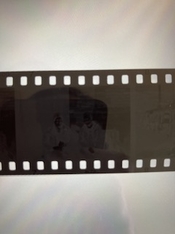Ah. There's something totally wrong there. This is not a regular developing problem, but some kind of massive fogging. Fog is commonly caused by the following things:
1. Light; i.e. light leaks in the camera or development tank, forgetting to load the center column in the development tank, or trying to handle unprocessed film under 'safelight' conditions as if it were photo paper.
2. Radiation; xrays especially as emitted by CT scanners exposes film.
3. Age; this is really a combination of (2) and normal chemical deterioration of an emulsion.
4. Chemical fogging; e.g. by bringing certain sulfur compounds (sodium sulfide, thiourea) in contact with the film before it is processed.
Applying the above to your film:
(1) usually gives more uneven fogging patterns; your film looks to be fogged very severely and evenly across the entire surface, assuming the rest of the film looks like the bit you've posted. The exception is safelight fogging, which tends to be complete and can very much look like this. Did you load this film from its cassette into the developing tank under safelight conditions?
(2) I've yet to see xray fogging anywhere near this strong. It would take many passes through even a modern CT scanner to build this kind of density.
(3) Only film that's very old (>10 years) and stored under very bad conditions (high heat) would be fogged this badly.
(4) It's generally uncommon for fogging compounds to come into contact with a development tank, unless you happen to have processed E6 slide film - but even then, the fogging agent would have washed out with subsequent processing steps. So this kind of fogging is really only likely if some kind of major mistake happened during processing and frankly I can't think of anything that is likely to happen. Contamination of the developer with a fogging compound is unlikely to the point of impossible, especially with store-bought Adonal.
Can you tell us please what happened with this film before you developed it?
PS a few things we can rule out: this is not the result of developing at a few degrees warmer than prescribed or a few minutes longer than optimal, so you don't have to worry if you looked up the right temperature, time & dilution for this film. The outcome wouldn't have been the kind of catastrophic failure we're seeing here.











